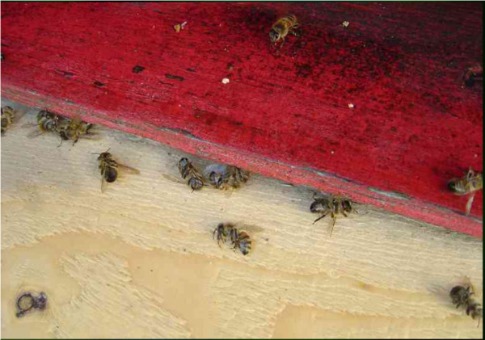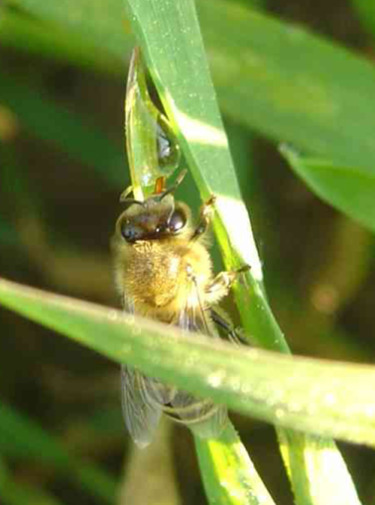Neonics & Bees:
Civil Servants Turn A Blind Eye To Study Flaws
How civil servants misled politicians and the public by using a flawed study to trash a robust, peer-reviewed one.
Some government civil servants seem quite happy to turn a blind eye to
serious flaws and omissions in studies that support the pesticide
manufacturer's case. They merely require 'trash science' to support registrations of poisons and keep them on the market, but 'unequivocal
evidence' to dislodge them.
This was the case with a Swiss study that a group of civil servants headed by Helen Thompson, used to support their criticism of an excellent, peer-reviewed and published independent study by Girolami et al that investigated guttation, neonicotinoids and bees (read more about this here).
The civil servants conducted the review as part of a report for government, investigating concerns about the potential risks of neonicotinoids to bees from contaminated guttation.
The Swiss study was called:
“Presence
of Clothianidin in Hives (Monitoring)”, and the objective of this study was
“Quantitatively and qualitatively establish the presence of neonicotinoids
(clothianidin)”
The
field study investigated clothianidin residues in guttation, pollen, honey and
dead bees. This is FERA's full summary of the study:
“The Swiss Federal Government for Agriculture commissioned a study in 2009 to assess the risks to honeybee colonies during sowing of maize seed treated with Poncho (25g ai/ 50,000 seeds, i.e. 0.5 mg ai/seed) through drift of dust and guttation. No effects were observed due to dust drift.
Guttation fluid collected from maize after emergence (7-10 days after sowing) was reported to contain 25-37 mg clothianidin/L reducing to around 0.1 mg/L by 40 days after sowing (as above the LD50 for clothianidin is around 0.084 mg/L) (Figure 3).
No clothianidin residues were detected in the honey bees or in honey
sampled from the colonies and no increased mortality was identified at honey bee
colonies placed at the edges of the treated fields and the colonies developed
normally”.
 Dead bees at a hive in a field study by German beekeepers.
Dead bees at a hive in a field study by German beekeepers.Am I reassured by the term 'government study'? Hardly! One only has to consider the acts of various civil servants, and to scrutinise the data, behaviour and methods of the responsible government officials to cure oneself of any misplaced trust!
Misleading the government and public at the tax payers expense, appears not to be below them.
 Honey bee drinking guttation - photograph from a field study by beekeepers in Germany.
Honey bee drinking guttation - photograph from a field study by beekeepers in Germany.What's wrong with FERA's treatment of the Swiss study?
In contrast with the treatment of the Girolami study, there is no criticism of the Swiss study, and you might think from the description that the study was robust and trustworthy.
The truth is entirely the opposite, but I am quite comfortable that Thompson et all more than likely will never have expected anyone in the government to actually read the Swiss study (it was in French anyway) - and after all, they would have assumed that Thompson et al would represent the studies fairly.
Swiss Study - Summary
In this deeply flawed experiment, the only part that could be considered a little robust was the measuring of clothianidin in the guttation samples - of which the authors found high concentrations. Thompson et al do not draw attention to this fact, and the figures will mean little to those with little background information.
There were 2 elements to the test.
Test 1
- A 2 hectare field was used – this is TINY - foraging bees
will fly several kilometres – EFSA state that even at only 2.5 km - a relatively
short flying distance, this corresponds to a theoretical foraging area of 19.6
km2, i.e., about 2000 hectares, in contrast to the 2ha used in the study.
- Of this tiny field, only 36% of it was sown with clothianidin,
the pesticide that was the subject of the study!
Thompson et al cynically fail to mention this grave inadequacy.
Yet this is the same group of people that keep wittering about ‘field realistic conditions’! If you know of any modern agricultural crop field, where not only is the field itself tiny, but only about a third of it is actually sown in such a manner, I'd be surprised to hear of it! - So what they are saying is, 74% of this tiny field had no
clothianidin at all - the very substance they were testing for!
- To be fair, the Swiss study technically complies with the EU's regulatory tests: EPPO 170 guidelines, which state the field
should be at least 1 ha in size, but they don’t stipulate it has to be sown
completely with the pesticide being tested.
This is one example of the wishy washy wriggle-room allowed in the EU's regulatory system for insecticides. - It turns out that what was treated
with clothianidin in reality, were 8 rows of corn, that were by the side of
wildflower strips, close to apple trees and dandelions.
- The rest of the field was sown with:
Gaucho - imidacloprid (systemic neoniocotinoid)
Cruiser - thiamethoxam (systemic neoniocotinoid)
Mesorol - which is not a systemic neoniocotinoid. It is a bird repellent and molluscicide and a non-systemic carbamate pesticide. - The author does not state what proportion of the field was
treated each with Mesorol, Gaucho and Cruiser.
The study does not even refer to these other pesticides later – so astonishingly, we don’t know anything further about residues of the other neonicotinoids (imidacloprid and thiamethoxam).
FERA, who were so eager to trash the Girolami study, do not draw attention to this point either. - Anyway, colonies with 20,000 bees each were installed by the
side of the clothianidin treated field (with just 8 treated corn rows by the
side of wildflower strips).
6 colonies of bees were used on this tiny field – 3 on each side – in reality, these colonies must have been close together – a regulatory field trial fault also identified by EFSA.
4 colonies from the sample of 6 (2 from each side) were used for monitoring of dead bees collected in traps at the hive.
However, this trial would not be able to take account of bees that did not return to the hive, due to disorientation or death from pesticide.
Pollen and honey samples were collected from the remaining 2 hives and were analysed for residues of clothianidin. - In the case of the honey, the samples were taken 3-5
weeks before and after planting the corn.
-
The trial began 17th April – the seeds were sown April 23rd.
The trial lasted ONLY 50 days from April 23rd (where April 23rd = 0 in the summary table).
50 days also included the time taken for the corn seedlings to appear, so this is certainly insufficient time to see:
- chronic effects;
- colony effects;
- behavioural effects on the bees.
Basically, this is a very short, and insubstantial study - taking into account that in their leaflet “The Secret Life Of Termites”, Bayer CropScience state that it takes a period of 3 months to kill a colony of termites with their imidcloprid termite killer.
- Apart from that, guttation was collected from the corn 14 times and analysed in the lab
for clothianidin.
Test 2
- The second field test was only 200m to 300m from the first
field test.
- The field was surrounded by wildflowers, dandelions, clover.
- The
bee colonies were placed on either side of the 1 hectare field in a meadow,
onto which a strip was built (what size? - we are not told!) and upon which, seeds treated with
Poncho (clothianidin) were sown.
- 3 honey bee colonies
were placed on either side of the meadow 16 days before planting time.
During this time, the bees would have been busy foraging elsewhere, building stocks in the hive (that would then be analysed for residues). - The rest of the field study is of the same standard of ‘science’ (if you can call it that) as above. Clothianidin residues were measured, with predicable results.
Results:
- It's hardly surprising that in this farce of a 'study', the authors find "no significant mortality" of
bees.
It is pretty obvious there is no possibility to consider bees lost in the field and failing to return to the hive due to disorientation or poisoning. This is not discussed - not that the study design was robust anyway. - They find, however, 10 dead honey bees per day.
Note that in a bumble bee colony, losses of 10 bees per day would be devastating, since a colony may typically only consist of about 160 bumble bees. There is no discussion of potential relevance for other pollinators. - The authors do not detect residues of clothianidin in pollen and
honey, with the exception of one sample of pollen. However, they do detect contamination
in ONE sample. The authors state this is likely to be caused by increased
exposure to clothianidin of the dandelions close by, due to frequent use of the
field for trials.
That's an interesting admission, that could have several implications:
- field margins are not safe from contamination (confirmed in other studies already - e.g. Tapparo et al);
- it may suggest danger of contamination from residues from previous sowings (taking into account that neonicotinoids are persistent in soil). - Guttation from corn: The authors find levels of clothianidin in guttation samples
from 27 to 37,000 microlitres per litre. Even the
authors (using the debatable LD50 measure) have to concede that this is
high....
........but since, during their unrealistic experiment, they haven’t found any clothianidin residues in dead bees, honey or pollen during the time period the corn was guttating, the authors conclude this must mean the guttation doesn’t pose a threat.
But they advise that if water is of limited availability to the bees, then beekeepers should engage in good beekeeping practice, by supplying water in the beehive.
(Could some-one also ask them to do the same for the wild bees and invertebrates at risk as well, please?) - Within their discussion they refer to bee poisoning cases in
Germany, and state that no such observations have been recorded in this
experiment.
Could that be because the German study reflected reality in which beekeepers collected evidence from actual fields and real life scenarios, where as this unrealistic Swiss Government study does not? I suspect this is the case. - Thompson et al state that the honey bee colonies 'developed normally'. Hardly a surprise given the methodology - not that the study lasted long enough to accurately assess whether this would have been the case even if all other elements of the study had been robust.
When no genuine weakness was evident from the Girolami work, it seems Thompson et al were quite happy to imply them very strongly, using flawed or spurious data to support their assertions.
If you found this page helpful or interesting, I'd really be grateful if you would share it with others - if not this page, perhaps another, such as Gardening For Bees.
Thank you so much :) .